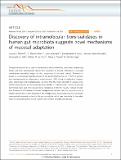Discovery of intramolecular trans-sialidases in human gut microbiota suggests novel mechanisms of mucosal adaptation
Abstract
The gastrointestinal mucus layer is colonized by a dense community of microbes catabolizing dietary and host carbohydrates during their expansion in the gut. Alterations in mucosal carbohydrate availability impact on the composition of microbial species. Ruminococcus gnavus is a commensal anaerobe present in the gastrointestinal tract of >90% of humans and overrepresented in inflammatory bowel diseases (IBD). Using a combination of genomics, enzymology and crystallography, we show that the mucin-degrader R. gnavus ATCC 29149 strain produces an intramolecular trans-sialidase (IT-sialidase) that cleaves off terminal α2-3-linked sialic acid from glycoproteins, releasing 2,7-anhydro-Neu5Ac instead of sialic acid. Evidence of IT-sialidases in human metagenomes indicates that this enzyme occurs in healthy subjects but is more prevalent in IBD metagenomes. Our results uncover a previously unrecognized enzymatic activity in the gut microbiota, which may contribute to the adaptation of intestinal bacteria to the mucosal environment in health and disease.
Citation
Tailford , L E , Owen , C D , Walshaw , J , Crost , E H , Hardy-Goddard , J , Le Gall , G , de Vos , W M , Taylor , G L & Juge , N 2015 , ' Discovery of intramolecular trans- sialidases in human gut microbiota suggests novel mechanisms of mucosal adaptation ' , Nature Communications , vol. 6 , 7624 . https://doi.org/10.1038/ncomms8624
Publication
Nature Communications
Status
Peer reviewed
ISSN
2041-1723Type
Journal article
Description
The authors acknowledge the support of the Biotechnology and Biological Sciences Research Council (BBSRC), this research was partly funded by the BBSRC Institute Strategic Programme for The Gut Health and Food Safety (BB/J004529/1) and by the BB/L008602/1 BBSRC-responsive mode grant. We also acknowledge support from the EU FP7 TORNADO programme. The research of WMdV was supported by the Academy of Finland, European Research Council and the Netherlands Organization for Scientific Research.Collections
Items in the St Andrews Research Repository are protected by copyright, with all rights reserved, unless otherwise indicated.

